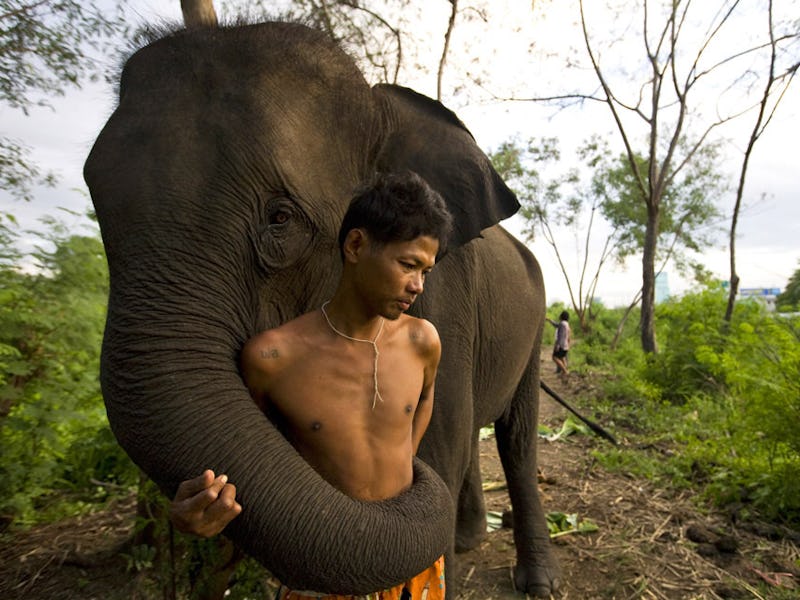The Same Predictor of Lifespan Is Shared Across Humans and Animals
Measured in creatures like elephants, goats, and humans, one metric shows how long a species will live.

When it comes to selling snake oil, nobody does it quite like the anti-aging industry. But it does get one thing right. Telomeres, the tiny end caps on our chromosomes, seem to protect against aging-related disease, and anti-aging researchers suspect that slowing down how fast telomeres shrink can slow the process of aging. New research published Monday in the Proceedings of the National Academy of Sciences confirms this connection across animal species.
Nobody has successfully lengthened telomeres or slowed down their shrinkage, but previous studies on mice and humans have shown that telomere shortening is linked to aging. The new paper shows that this effect holds true for a wide variety of animal species, including birds and mammals.
The team of Spanish authors showed that the rate of telomere shortening in eight different animals strongly predicted the animals’ average life spans. They showed that the longest-lived animals had telomeres that took the longest time to shorten.
“The results shown here indicate that the telomere shortening rate of a species can be used to predict the life span of that species, at least with the current dataset,” write the study’s authors, led by Kurt Whittemore, Ph.D., a researcher at the Spanish National Cancer Research Center.
This study showed that the faster telomeres shortened, the shorter the animals lived.
Each time our cells divide, the telomeres protecting the DNA in their nuclei shorten. Once they get too short, they can no longer keep chromosomes from unraveling. This means that over time, as telomeres shorten, cells are at greater risk of damage and death. For this reason, some anti-aging therapies, like the unproven approach of the controversial biotech company BioViva, aims to lengthen telomeres.
But as the PNAS study shows, absolute length may not be as important as the rate of shortening.
In the study, regardless of the lengths of animals’ telomeres, it was the rate at which they shortened that was closely correlated with the length of their lifespan.
“We observed that mean telomere length at birth does not correlate with species life span since many short-lived species had very long telomeres, and long-lived species had very short telomeres,” the authors write.
The team used a fluorescence technique to measure telomere lengths in cells from a group of very different animals: lab mouse (Mus musculus), goat (Capra hircus), Audouin’s gull (Larus audouinii), reindeer (Rangifer tarandus), griffon vulture (Gyps fulvus), bottle-nose dolphin (Tursiops truncatus), American flamingo (Phoenicopterus ruber), and Sumatran elephant (Elephas maximus sumatranus).
To create a linear model of how telomeres shorten over time, the team measured samples from different-aged animals of the same species. By comparing these telomere lengths, the team could get a sense of how the telomere lengths of an older individual compare with those of a younger one.
Telomeres are like the plastic caps at the end of our shoe laces: They keep chromosomes from fraying.
They observed that the mouse, the shortest-lived animal in the study, has an extraordinarily fast rate of telomere shrinking — about 100 times that of a human. The telomere shortening rates of the other animals fell somewhere between those of mice and humans, and all of them correlated to their average lifespans.
The authors admit that future studies on this topic should include a longitudal design, which would follow animals or humans over the course of their entire lives. Since some of the study animals have very long life spans, doing so would not have been possible in the current study.
This study adds support to the idea that the effects of telomere shortening are closely tied to the cell death and damage associated with aging-related diseases. Even though anti-aging researchers have failed to extend human lifespans, this particular hypothesis suggests that they may at least be looking in the right place.
But so far, the best researchers in the field have not been able to slow telomere shortening, even though some have suggested that exercise can do the trick.
“We don’t have any compound that will actually elongate telomeres, despite what you can read on many websites,” Nobel Laureate Carol Greider, Ph.D., previously told Inverse.
“Of course, because we have patients in the hospital dying of these diseases, if there was some sort of a treatment, we would be looking into it. But we have looked into those things that are out there, and it’s basically snake oil.”
Abstract: Telomere shortening to a critical length can trigger aging and shorter life spans in mice and humans by a mechanism that involves induction of a persistent DNA damage response at chromosome ends and loss of cellular viability. However, whether telomere length is a universal determinant of species longevity is not known. To determine whether telomere shortening can be a single parameter to predict species longevities, here we measured in parallel the telomere length of a wide variety of species (birds and mammals) with very different life spans and body sizes, including mouse (Mus musculus), goat (Capra hircus), Audouin’s gull (Larus audouinii), reindeer (Rangifer tarandus), griffon vulture (Gyps fulvus), bottle-nose dolphin (Tursiops truncatus), American flamingo (Phoenicopterus ruber), and Sumatran elephant (Elephas maximus sumatranus). We found that the telomere shortening rate, but not the initial telomere length alone, is a powerful predictor of species life span. These results support the notion that critical telomere shortening and the consequent onset of telomeric DNA damage and cellular senescence are a general determinant of species life span.